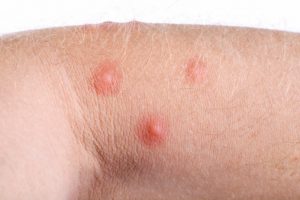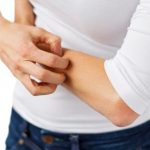 Flea bites and bed bug bites can cause some serious itching – just the thought of tiny insects crawling on your body can make you itchy, doesn’t it? Fleas are tiny insects that are commonly found on pets and animals. If your pet is treated, your risk of contracting a flea bite is far lower. But if you have a pet that spends a lot of time outdoors, getting your pet treated to prevent fleas is highly recommended. Fleas are not just a threat to your bellowed pet – they can be irritating for you as well.
Flea bites and bed bug bites can cause some serious itching – just the thought of tiny insects crawling on your body can make you itchy, doesn’t it? Fleas are tiny insects that are commonly found on pets and animals. If your pet is treated, your risk of contracting a flea bite is far lower. But if you have a pet that spends a lot of time outdoors, getting your pet treated to prevent fleas is highly recommended. Fleas are not just a threat to your bellowed pet – they can be irritating for you as well.
Bed bugs reside, well, in the beds and mattresses. They thrive on beds because there is plenty of dead skin, which comes off while we sleep. If a bed bug can’t find a human host to feed on, it may hop onto pets as well. The key to preventing bed bugs is to maintain a clean mattress and bedspread.
Advertisement
When bitten by a flea, you will become quite itchy, so your natural instinct is to scratch. Unfortunately, scratching makes the bite much worse and can lead to further itchiness and infection.
Bed bugs also cause itching and sometimes an allergic reaction. Some people mistaken bed bug bites with mosquito bites and thus treat them incorrectly. Bed bugs prefer cooler temperatures, while fleas like it a bit hotter. For this reason, you often won’t see bed bugs on a hairy animal.
Let’s look at the similarities and differences between bed bug bites and flea bites, along with treatment options and prevention measures.
Difference between flea bites vs. bed bug bites
Flea bites will often appear as small clusters of dots that are red, hard, and swollen – similar to a mosquito bite. Fleas tend to bite the human host randomly, whereas beg bugs bite strategically in a linear row.
Flea bites are often found on the legs and ankles, the easiest access points for the insects. Bed bug bites can be found anywhere on the body.
Both types of bites cause itchiness and swelling and can be a nuisance for both human and animal hosts.
Symptoms of flea bites and bed bug bites
Flea bites cause itchiness, look red and swollen, and will appear in less than an hour after the bite. Legs and feet are common targets, and scratching can cause a secondary infection. Some may experience hypersensitivity to flea bites, resulting in a greater allergic reaction.
Beg bug bites also cause red bumps and intense itchiness with a darker red spot in the middle of the bite. Bites are rough, appear in a linear row, and are most commonly found on the face, neck, arms, and hands. Some individuals may develop blisters or hives, while others may not even have any bumps.
Chart: Flea bites vs. bed bug bites
| Bed bugs | Fleas | |
| Appearance | Small, flat, reddish-brown | Small, long, red, or brown |
| Size | 4-5 mm long and 1.5-3 mm wide | 1.5-3.3 mm long |
| Disease transmission | Does not spread disease | Can spread disease |
| Reaction | Itchy, can lead to a rash | Bite can be felt, swelling |
| Identification | Dark spots on bedding, eggs and rust stains on sheets | Visible on pets |
| Location | Near cracks in bed frame, piping, and seams of mattress | On pets and upholstery |
| Treatment | Heat articles of clothing and bedding, use pesticides | Vacuum upholstery, beat rugs outdoors, treat pets |
| Prevention | Reduce clutter, use protective casing on mattress, check secondhand furniture before bringing into home | Wash pet bedding each week. Vacuum daily. |
Treatment options for flea bites and bed bug bites
 Many over-the-counter medications and ointments can aid to relieve the itchiness and swelling for both bed bug bites and flea bites.
Many over-the-counter medications and ointments can aid to relieve the itchiness and swelling for both bed bug bites and flea bites.
For flea bites specifically, wash the area with soapy water and apply an antiseptic cream. An icepack can relieve swelling along with itchiness. Avoid excessively hot water as it can trigger greater itchiness.
Over-the-counter creams and medications that can reduce itchiness for both bed bug and flea bites are hydrocortisone cream, calamine, and Benadryl. Creams should not be put onto areas with open sores or wounds.
Other home remedies include applying aloe vera, washing the bites with black tea, green tea, or steeped lavender, and resisting the urge to scratch as much as possible as it will only make the itchiness worse.
For bed bug bites specifically, you can make a paste with water and baking soda, apply to the bite allowing to dry, and rinse off an hour alter. You can also saturate a cotton ball with lemon juice or St. Johns Wort and dab it onto the bite. Another option is taking a warm bath infused with peppermint oil, powdered oatmeal, baking soda, or Alka-Seltzer.
Preventative measures for flea bites and bed bug bites
Advertisement
Preventative measure for flea bites include:
- Consume garlic as flea hate garlic.
- Make a citrus-infused spray bottle to spray on your legs and ankles.
- Spray or dab on essential oils like lavender onto legs and ankles.
- Fill a glass with water and apple cider vinegar and leave it where fleas are the most problematic. This concoction will trap them as they are attracted to the odor.
- Have your pet treated for fleas.
- Vacuum regularly.
- Wash your pet frequently.
Preventative measures for bed bug bites include:
- Wrap your mattress in a protective casing.
- Tape up any holes in the mattress or bed frame.
- Eliminate clutter around the bed.
- Always inspect luggage and clothing when returning from a trip.
- Wash all clothing after purchase or returning from a trip.
- Get rid of infested mattresses or box springs.
- Regularly wash your bedding.
- If all else fails, try pesticides.
By following these preventative measures for bed bugs and fleas, you can lower your risk of being bitten.
